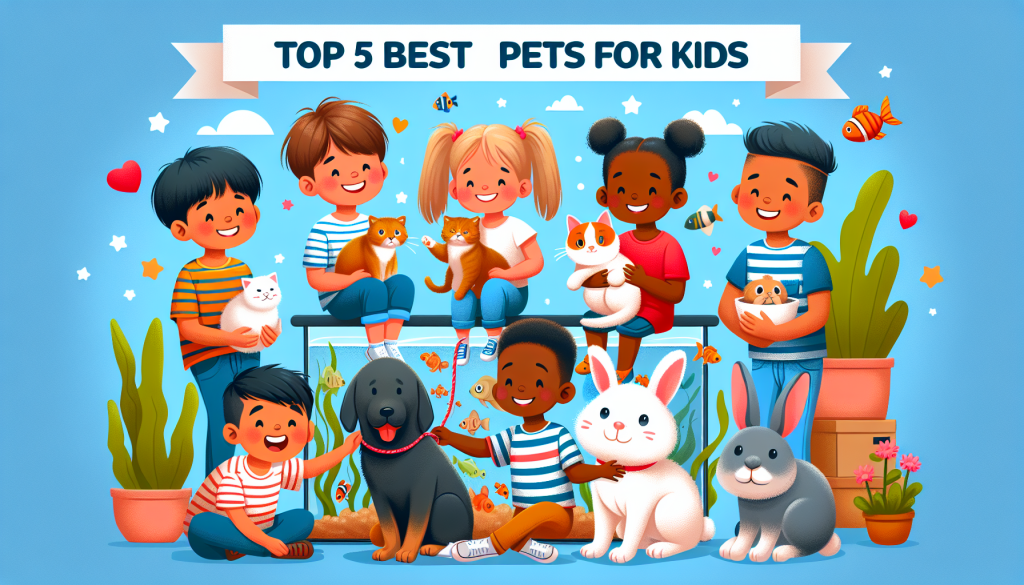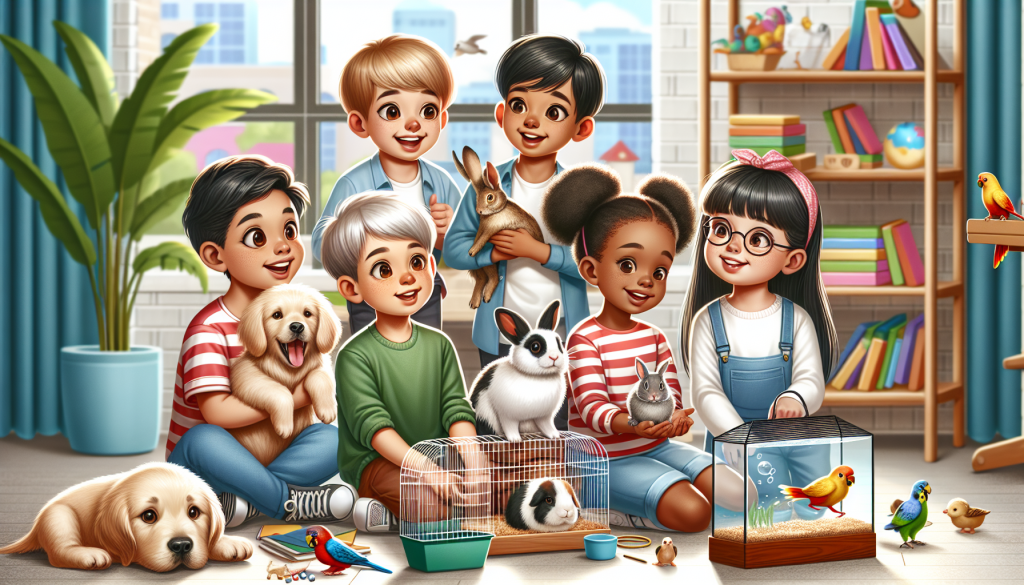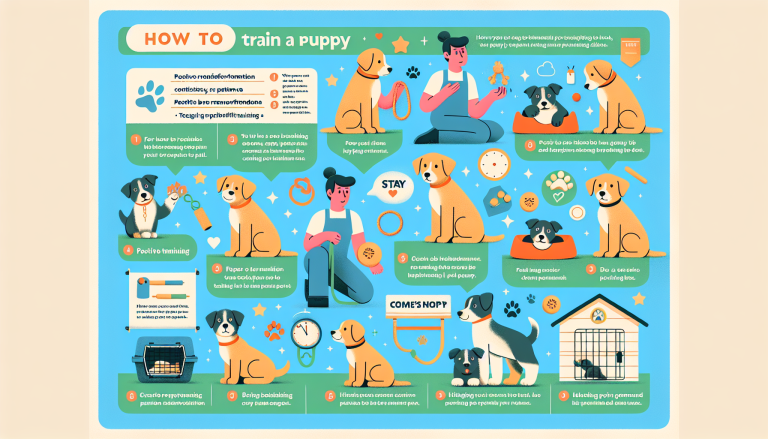Looking to bring some joy and companionship into your child’s life? Look no further! In this article, we will be highlighting the top 5 best pets for kids. From cuddly rabbits to talkative parakeets, we’ve got plenty of options that are sure to put a smile on your little one’s face. Whether your child is an animal lover or simply seeking a new furry friend, we have considered various factors such as size, temperament, and ease of care to ensure these pets are perfect for kids of all ages. So, get ready to explore the exciting world of pet ownership and find the ideal companion for your family!
Table of Contents
ToggleDogs
Exercises and plays with kids
Dogs are a fantastic choice for families with children. They are incredibly playful and love joining in on all sorts of activities. Whether it’s a game of fetch in the backyard or a run through the park, dogs are always up for some fun. They will keep your kids active and engaged, ensuring that they get plenty of exercise themselves.
Loyal and protective
One of the greatest things about having a dog as a family pet is their loyalty and protective nature. Dogs form strong bonds with their owners, especially children, and will go above and beyond to keep them safe. They are fiercely protective and will act as a source of comfort and security for your little ones.
Good for active families
If your family loves the outdoors and leading an active lifestyle, getting a dog is an excellent choice. They thrive in active environments and enjoy being part of all your adventures. From hiking and camping to playing sports in the backyard, dogs will be the perfect companions for your family’s active lifestyle.
Require grooming and training
It’s important to note that dogs require regular grooming and training. Grooming involves brushing their fur, bathing them, and keeping their nails trimmed. Training, on the other hand, helps dogs understand basic commands and ensures that they are well-behaved members of the family. These responsibilities can be shared amongst family members to make it a fun and enjoyable experience.
Different breeds for different needs
When choosing a dog, it’s essential to consider your family’s lifestyle, living situation, and the temperament of the breed. Different dog breeds have different needs and characteristics. Some breeds are better suited for families with young children, while others are more suitable for families with older kids. Do thorough research, visit shelters, or consult with a reputable breeder to find the perfect dog breed for your family’s needs.
Cats
Affectionate and low-maintenance
Cats make wonderful pets for families with children. They are known for their playful nature and love to cuddle up with their owners. Cats are generally low-maintenance pets and can entertain themselves for hours, making them suitable for families who may have busy schedules.
Playful companions for kids
Cats are terrific playmates for children. They enjoy interactive play, such as chasing toys or dangling strings, which can provide hours of fun for both kids and cats. They are agile and can keep up with the energy levels of children, making them great companions for playtime.
Varying personality types
One of the fascinating aspects of cats is their varying personality types. Some cats may be independent and prefer their own space, while others are social butterflies and love being around people. Take the time to interact with different cats to find one that aligns with your family’s preferences and dynamics.
Easier to care for than dogs
Compared to dogs, cats are generally easier to care for. They are self-grooming animals and take care of their cleanliness. They also use litter boxes for their bathroom needs, which makes it easier to manage compared to taking dogs outside for bathroom breaks. However, regular feeding, occasional grooming, and visits to the veterinarian are still necessary to maintain their health and well-being.
May trigger allergies in some children
It’s worth mentioning that some children may be allergic to cats. Before bringing a cat into your family, make sure to check if anyone in the household has allergies. If there are allergies present, talk to your doctor about potential solutions or consider other pet options that may be hypoallergenic.
Guinea Pigs
Social and friendly
Guinea pigs are small, gentle creatures that make excellent companions for children. They are known for their sociable nature and enjoy interaction with their owners. Guinea pigs love being petted, talked to, and even enjoy cuddling once they trust their human family.
Easy to care for
Guinea pigs are relatively easy to care for, making them a great choice for first-time pet owners and families with young children. They require a clean and spacious cage, fresh food and water, and daily interaction and attention. Regular cage cleaning and bedding changes are necessary to maintain the health and well-being of these adorable pets.
Can teach responsibility
Owning a guinea pig can be an excellent way to teach children about responsibility. In addition to daily care, children can learn about the importance of routine, cleanliness, and showing compassion towards animals. Taking on the responsibility of caring for a guinea pig can instill valuable life skills and help develop a sense of empathy in children.
May not withstand rough handling
While guinea pigs are generally gentle creatures, they may not withstand rough handling or mishandling by young children. It’s crucial to teach kids how to handle them properly with care and respect. Supervision and guidance from an adult are necessary, especially when interacting with guinea pigs for the first time.
Require regular cleaning of their habitat
Guinea pigs require proper hygiene and a clean living environment. Their cages need to be cleaned regularly, and bedding should be changed to prevent the buildup of odor and bacteria. Regular cleaning not only ensures the health of the guinea pig but also keeps your home environment clean and tidy.
Fish
Low maintenance
Fish are a popular choice for families looking for low-maintenance pets. They require minimal attention compared to other animals on this list. They don’t need to be taken on walks or require grooming. Fish simply need a well-maintained tank with proper filtration, regular feeding, and occasional tank cleaning.
Relaxing to watch
One of the unique qualities of fish is that they are incredibly relaxing to watch. The peaceful movement of their fins and the serene environment of an aquarium can provide a sense of tranquility for both children and adults. It’s a great way to unwind and enjoy the beauty of nature from the comfort of your home.
Help teach responsibility
Caring for fish can be an excellent way to teach children about responsibility. They need to learn the importance of regularly feeding the fish, checking water quality, and maintaining cleanliness in the tank. Inculcating these routines from a young age can help instill a sense of responsibility and discipline in children.
No cuddling or interactive play
It’s important to note that fish are not pets that can be cuddled or played with in a traditional sense. They require a different kind of interaction. Observing their movements, learning about different species, and taking on the responsibility of their care can be a rewarding experience for children, despite the lack of physical interaction.
Need regular tank cleaning
Clean water is essential for the health and well-being of fish. Regular tank cleaning, including changing a portion of the water and maintaining the proper balance of chemicals, is necessary to ensure the longevity of the fish. While it may seem like a simple task, it’s crucial to follow the necessary steps and guidelines to provide a thriving environment for your aquatic friends.
Birds
Can be entertaining and talkative
Birds can be incredibly entertaining with their quirky personality traits and potential for mimicry. From whistling tunes to mimicking human speech, birds have the ability to bring joy and laughter to their human companions. They provide a unique form of entertainment and can be a source of constant amusement for kids.
Teach kids about different species
Owning a bird can serve as an educational opportunity for children. Kids can learn about different bird species, their natural habitats, and their unique characteristics. Engaging in activities like bird-watching, studying bird behaviors, and providing proper care can foster a sense of curiosity and appreciation for nature in children.
Require mental stimulation
Birds are intelligent creatures that require mental stimulation to thrive. They need toys, puzzles, and regular interaction with their human family to prevent boredom. Providing a variety of toys and engaging in interactive playtime can help keep birds mentally stimulated and prevent behavioral issues.
Need regular attention and care
Birds require regular attention and care from their owners. They are social animals and need interaction and companionship to thrive. Spending time with your pet bird, talking to them, and providing opportunities for physical exercise are crucial for their well-being. It’s important to ensure that you have the time and commitment to dedicate to their care before bringing a bird into your home.
May not be suitable for young children
Birds may not be suitable for very young children, especially those who may be too rough or unpredictable in their behavior. Birds can get easily irritated or stressed in certain situations, which can lead to behavioral problems. It’s essential to consider the age and maturity level of your children before deciding to adopt a bird as a pet.
Hamsters
Small and low-maintenance
Hamsters make great pets for kids, especially if you have limited space or are looking for a small pet. They are low-maintenance, requiring a relatively small cage compared to other animals. Hamsters also have minimal grooming needs, making them a suitable choice for families with busy schedules.
Can be a child’s first pet
Hamsters are often considered an ideal first pet for children. They are relatively easy to care for and provide a good introduction to pet ownership. Taking care of a hamster can teach young children about basic pet care, including feeding, cleaning, and creating a suitable environment for their tiny friend.
Can bite if not handled properly
It’s important to remember that hamsters have a natural instinct to bite if they feel threatened or mishandled. They have small teeth that can cause injury if they bite, particularly if they are scared or startled. Educating children on proper handling techniques and supervising their interactions is crucial to keep both the child and the hamster safe.
Require proper housing and exercise equipment
Hamsters need a suitable habitat and exercise equipment to stay healthy and happy. They require a well-ventilated cage with enough space to move around, build nests, and exercise. Providing them with a stimulating environment that includes tunnels, wheels, and chew toys is essential to prevent boredom and promote their overall well-being.
Short lifespan
It’s important to be aware that hamsters have a relatively short lifespan compared to other pets. Depending on their species, they may live between 1.5 to 3 years on average. This lifespan may need to be considered when choosing a pet, especially if you’re looking for a long-term commitment.
Rabbits
Affectionate and social
Rabbits are known for their affectionate and social nature. They can form strong bonds with their human companions and enjoy being petted and cuddled. Rabbits are gentle animals and can offer endless affection to children who are willing to reciprocate their love.
Can be litter-trained
One of the biggest advantages of having a rabbit as a pet is that they can be litter-trained. Similar to cats, rabbits can be taught to use a litter box, which makes cleaning up after them much easier. A litter-trained rabbit can be a great relief for busy families.
Require space for exercise
Rabbits are active animals and require plenty of space to exercise. Having a designated area or providing them with a large indoor or outdoor enclosure is crucial to keep them physically and mentally stimulated. Regular exercise is not only important for their overall health but also helps prevent behavioral issues.
Need proper diet and grooming
Providing a well-balanced diet is essential for the health of rabbits. They are herbivores and require a diet rich in hay, fresh vegetables, and a limited amount of pellets. Additionally, rabbits require regular grooming, including brushing their fur and keeping their nails trimmed. Grooming sessions can also be an excellent opportunity for bonding with your pet rabbit.
May scratch or bite when frightened
Rabbits, like any other animal, have defense mechanisms that they may resort to when frightened or feel threatened. They may scratch or bite if they are scared or mishandled. It’s important to teach children to handle rabbits gently and provide them with a safe and secure environment to minimize any potential risks.
Turtles
Fascinating to observe
Turtles can be fascinating pets for kids. Watching them move slowly and observing their unique shells can spark curiosity and provide a valuable learning experience. They offer children a window into the world of reptiles and the importance of preserving their natural habitats.
Quiet and low-maintenance
Turtles are known for their quiet and low-maintenance nature, making them suitable pets for families with young children. They don’t require constant attention or interaction and can provide a sense of tranquility for both kids and adults.
Long lifespan
Turtles have a significantly longer lifespan compared to many other pets. Depending on the species, they can live for several decades. This longevity can be a rewarding aspect for children, as they have the opportunity to grow up alongside their pet turtle and develop a lifelong bond.
Require special habitat and diet
Providing the proper habitat and diet for turtles is crucial for their well-being. Turtles typically require an aquarium with both water and dry areas to give them the freedom to swim and bask in heat. They also need a balanced diet consisting of a variety of leafy greens, vegetables, and occasional protein sources. Educate yourself on the specific needs of the turtle species you’re interested in before bringing one home.
May carry salmonella bacteria
It’s essential to be aware that turtles can carry salmonella bacteria, which can potentially be harmful to humans, especially young children who are more susceptible to infections. Proper hand hygiene and appropriate cleaning protocols, such as regularly washing hands and disinfecting the turtle’s habitat, can help minimize the risk of salmonella transmission.
Rats
Intelligent and trainable
Rats are highly intelligent creatures and can be trained to perform various tricks and behaviors. They are quick learners and enjoy mental stimulation, making them great companions for children who are interested in teaching their pets new tricks.
Affectionate and playful
Contrary to popular belief, rats can be incredibly affectionate pets. They enjoy human interaction and form strong bonds with their owners. Rats are also naturally playful animals, often engaging in games with their owners, which can provide hours of entertainment for both children and rats.
Interesting to observe
Rats have fascinating behaviors and can be interesting to observe. From their grooming rituals to their ability to solve puzzles, rats have a complex social hierarchy and exhibit various intriguing behaviors. Owning a rat can create opportunities for children to learn and appreciate the intelligence and uniqueness of these small creatures.
Shorter lifespan
It’s important to note that rats have shorter lifespans compared to many other pets. On average, rats live between 2 to 3 years. This shorter lifespan should be taken into consideration when deciding to get a pet rat as children may need to understand and cope with the eventual loss of their furry friend.
May not be suitable for very young children
Rats may not be suitable for very young children, especially those who may not have developed the necessary understanding and gentleness required to handle them properly. Supervision and guidance are essential, especially during interactions to ensure the safety and well-being of both the children and the rats.
Gerbils
Active and entertaining
Gerbils are active and highly entertaining pets. They enjoy burrowing, climbing, and exploring, which can provide hours of amusement for kids. Gerbils have unique personalities and can be interactive and playful, making them great companions for children.
Social and enjoy human interaction
Gerbils are social animals and enjoy human interaction. They can form strong bonds with their owners and appreciate the attention and affection they receive. Spending time with gerbils, talking to them, and providing them with toys and activities can help keep them mentally stimulated and happy.
Require proper housing and exercise equipment
Gerbils require a suitable habitat with plenty of space to move around, dig, and engage in their natural behaviors. They also need exercise equipment, such as wheels and tunnels, to burn off their energy and provide mental stimulation. Providing the right environment and enriching their surroundings can contribute to their overall well-being.
Not suitable for very young children
Gerbils may not be suitable for very young children who may not have the necessary understanding and gentleness to handle small animals. They have delicate bodies that require careful handling to prevent injury. It’s crucial to teach children how to interact with gerbils in a gentle and respectful manner.
May bite if scared or mishandled
Gerbils, like any other small animal, may bite if they feel scared, threatened, or mishandled. It’s important to educate children on the proper handling techniques and the importance of respecting the gerbil’s boundaries. Supervision and guidance from an adult are necessary, especially when children are interacting with gerbils for the first time.
By considering the characteristics and needs of different pets, you can choose the best pet for your family’s lifestyle, preferences, and the age of your children. Remember, owning a pet is a long-term commitment that requires love, care, and responsibility. With the right pet, your family can experience the joys and benefits that come with having a furry, feathery, or scaly friend by your side.








